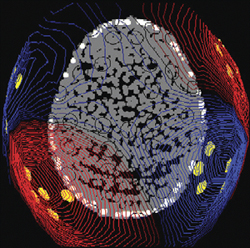 |

|
 |
An axial view of the cortically-generated magnetic field of a human listener, measured using whole-head magnetoencephalography (MEG), at a single moment in time.
The Isofield contours in red indicate the strength of outward magnetic flux. Blue contours indicate the strength of inward magnetic flux. The digitized scalp surface is grey.
For each hemisphere, a magnetic dipole-like pattern is centered over temporal cortex, and the neural generator itself, located in planum temporale, is an inferiorly flowing neuronal electric current.
The MEG channels responding more strongly in the center of each flux area are designated by filled yellow circles. |
|
A paper by newly minted University of Maryland Ph.D. Maria Chait (Neuroscience and Cognitive Science) and her advisors Associate Professor David Poeppel (Linguistics) and ISR-affiliated Assistant Professor Jonathan Simon (ECE/Biology) is featured on the cover of the journal Cerebral Cortex. "Neural Response Correlates of Detection of Monaurally and Binaurally Created Pitches in Humans" details the results of a MEG-psychophysical study that investigated the timing of formation of the percept of pitch and the generality of hypothesized ?pitch-center? in the brain.
May 19, 2006
|

